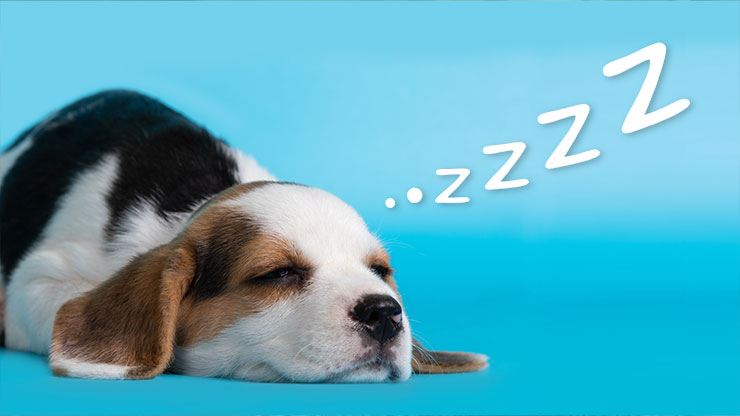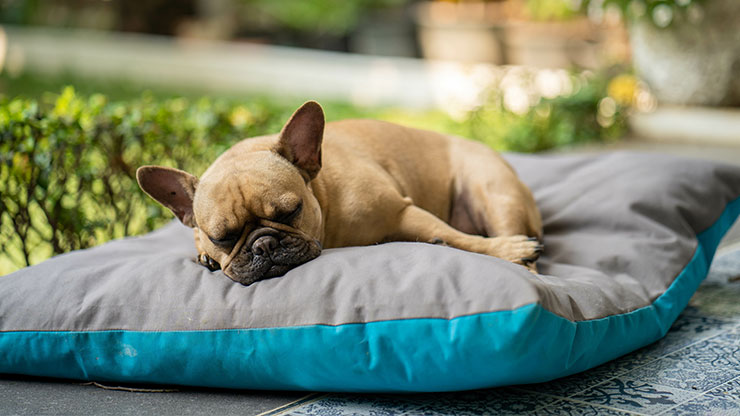
Pup Sleeping Disorders: Causes and Solutions
Sleep is a fundamental process in all mammals, including pet dogs. If you’ve ever battled against insomnia or been sleep-deprived because of a busy schedule, stress, or anxiety, then you know what a big toll missing sleep can take on your health. It is no different for dogs. As stated in a 2021 study by Alejandra Mondino and colleagues, sleep disturbances affect dogs’ physiological functions (including their cognitive and physical performance), immune response, and pain sensation. It also ups their risk of diseases. Just a few of the most common sleep disorders experienced by dogs include narcolepsy, REM sleep behavior disorders, and sleep breathing disorders. Sleep issues can also be a symptom of other diseases, and they can worsen the overall condition of dogs. Therefore, if you notice that your dog is restless or showing signs of sleep problems, then seeing your vet may be needed!
How Common Are Sleep Disorders Among Dogs?
No large-scale studies indicate a precise percentage of dogs with sleep disorders. However, we know that a dog’s size and age affect how long they sleep, and their size also indicates the amount of time they need to rest. For instance, puppies need lots of sleep—between 18 and 19 hours—so if they are awake for only four to five hours, don’t worry. This is typical! Most adult dogs snooze for between eight and 13.5 hours, with an average of just under 11 hours. They sleep longer at night than puppies do, but many enjoy napping for around 37% of the day. Senior dogs, meanwhile, wake up less often throughout the night and sleep later in the morning. They also sleep more during the day and take more frequent naps. With respect to size, large dog breeds like Mastiffs and Great Danes sleep more than their smaller counterparts. Giant breeds may need up to 18 hours of shut-eye, while small dogs need 14 to 16 hours. A dog can be affected by various sleep disorders, though, as mentioned above, some of the most common are narcolepsy, REM-related disorders, and breathing disorders. In this post, we shall discuss these disorders' signs and symptoms and what you can do about them.
Narcolepsy—Falling Asleep Suddenly
Narcolepsy is a disorder of the nervous system, primarily affecting young dogs and cats. When a dog experiences a narcoleptic attack, they may suddenly collapse. They may fall asleep in a fash and wake up abruptly as if nothing had occurred. Your dog probably relaxes in various positions. When they are exhausted, for instance, they may lie on their side, while if they are expecting to react quickly, they may sleep on their belly, with their head between their paws. During narcoleptic episodes, your dog will adopt their usual position. What makes their behavior odd is how suddenly they “drop” into sleep. Narcolepsy can be inherited but can also be caused by obesity or immune system disorders. Although it is not life-threatening, visiting your veterinarian for a check is a good idea. Narcolepsy cannot be treated, but don’t worry—you can do plenty to keep your dog safe. For instance, you can reduce the frequency and severity of events by staying by their side and helping them avoid known triggers. You can also ensure the space they play and rest in is safe and that the flooring is soft—so that they do not hurt themselves when collapsing. Some breeds are more likely to develop narcolepsy than others. These include Dachshunds, Doberman Pinschers, and Labrador Retrievers. Next, we will discuss a sleep disorder that can reduce your dog’s quality of sleep owing to the physical activity it provokes.
REM Sleep Behavior Disorder
REM sleep behavior disorder (RBD) in dogs is characterized by violent motor activity and complex behavioral phenomena that occur when your dog is in the REM stage of sleep. If your dog has REM sleep disorder, you will notice that while they are sleeping, they move their limbs violently, howl, bark, chew, growl, or bite. Episodes can occur both during short naps and during longer night sleeps. Film your dog while they sleep, so you can show your vet the behavior you are referring to. REM sleep disorder does not seem to affect some breeds more than others. Instead, researchers have found that the disorder usually arises when dogs are young and have been ill owing to tetanus. Sadly, dogs who have RBD do not spontaneously recover. Therefore, as with narcolepsy, it is vital to create a safe environment for them since, during an episode, they may injure themselves or even lash out and bite. A common treatment for this disorder is clonazepam (a benzodiazepine) which reduces physical activity during sleep. Some studies also suggest that the anti-seizure medication, potassium bromide, can help dogs with this condition. Next, we will discuss sleep breathing disorders, which can seriously impact your pup’s sleep quality.

Sleep Breathing Disorders
If you or someone you know has sleep apnea, you know how fatigued it can make you feel. Sleep apnea causes people and dogs to stop breathing for several seconds while asleep until they awaken with a jolt to breathe. These frequent awakenings result in poor-quality sleep and many short- and long-term health risks. Veterinarians usually recommend a diet for overweight dogs since being overweight increases the risk of sleep apnea. If the cause of the problem is a natural obstruction, then your vet might recommend surgery to fix a malformed area. Experts are also working hard to develop a particular CPAP machine for dogs. Currently used by humans, these machines deliver pressurized air into the airways through a dedicated mask and tube. Sleep breathing disorders are especially prevalent in breeds like English bulldogs, French bulldogs, chihuahuas, pugs, and Cavalier King Charles Spaniels.
Other Problems
Sometimes, sleeping concerns are related to other issues. For instance, if a dog has fleas, it can wake every time it feels a bit. Other issues that can interfere with sleep include arthritis, injuries, and frequent urination. Anxious and stressed dogs can also find it difficult to get a good night’s rest. Pain-related issues can be medicated, while anxiety and stress can be relieved by removing known triggers and ensuring your dog gets enough physical activity, considering their age and physical condition.
If your dog struggles with sleep, contact the vet for diagnosis and treatment. Many problems can be treated. Others require patience and making small accommodations, so your dog can enjoy greater comfort and stay safe. For instance, if your pet has narcolepsy or RBD, creating a safe, soft, pup-proof environment will help ensure they do not harm themselves due to their disorders.










